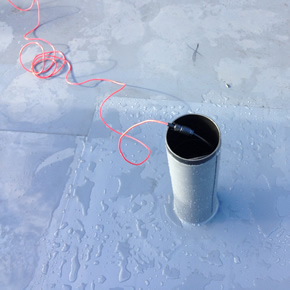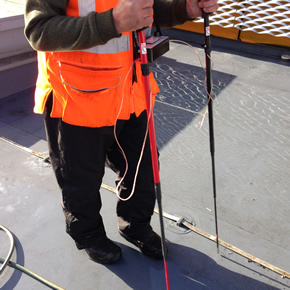
ILD waterproofing detection system provides flat roof reassurance
Designed to alert building owners to flat roof leakage and ingress, the International Leak Detection (ILD) waterproofing integrity testing system has provided reassurance for two decades. Sika finds out more…
Flat roof design has many advantages: it can result in lower building costs, and allows for potential development. The space can be transformed into a Solar or Green Roof, for example.
However, flat roofs are more prone to water ingress than pitched roofs, which can quickly shed waste water by design. Many designers, building owners, facilities managers and tenants fear leakage, which can be costly to combat.
ILD waterproofing integrity testing
In 1996, the International Leak Detection (ILD) was founded to solve this issue. As a waterproofing integrity testing system, ILD involves a trio of techniques.
The first, Electric Field Vector Mapping (EFVM) testing, is carried out by applying water on the surface of a roofing membrane to create an electric field. The water is then used a conductive medium; any breaches in the membrane will cause an electrical connection to occur.
ILD inspectors are able to follow the directional current of the flow to establish its point of entry.
The second technique, ProtectSys ‘B’, comprises an electro-conductive material, contact plates and contact boxes. The system is placed beneath the waterproofing membrane; should any moisture enter into its level, it will be able to determine the location of the defect.
ILD’s ProtectSys ‘WM’ early warning system utilises radio signals to measure temperature and relative humidity inside and outside a roof’s insulation layer. The measurements are transmitted to a central unit via radio signals; they are then mailed to a central computer by G.S.M, where the condition of the roof is analysed.
ILD has been guaranteed as a fault detection system: although there can be no absolute assurances against water ingress with flat roofs, ILD can prevent minor problems from developing further.
The Leak Detection application process
 The specified vapour barrier should be laid according to instructions; insulation boards should then be fitted onto the surface of the vapour barrier.
The specified vapour barrier should be laid according to instructions; insulation boards should then be fitted onto the surface of the vapour barrier.
The non-woven glass fleece should then be loose laid to the upper surface of the insulation boards, before the two contact plates can be fitted into the individual roof area (additional contact plates are required when the roof space exceed 1,500 square metres).
Contractors should then install two cable access duct components as close to the contact plates as possible. The contact plate cable must be brought up through the proprietary cable access duct component to allow the testing ILD technician access.
The single ply roofing membrane can then be fitted to the surface of the insulation boards.
Sika-Trocal,
Watchmead,
Welwyn Garden City,
Hertfordshire,
AL7 1BQ,
United Kingdom
Phone: 01707 394444
Fax: 01707 329129
Visit Supplier's page
Latest news

4th March 2025
S. Norton Group showcases £20m shredder for metals recycling CEOs
S. Norton Group hosted a tour of its latest £20m investment in state-of-the-art shredder technology for 17 senior leaders in the European metals recycling industry.
Posted in Articles, Building Industry News, Building Products & Structures, Building Services, Case Studies, Facility Management & Building Services, Plant, Equipment and Hire, Posts, Site Preparation, Sustainability & Energy Efficiency, Waste Management & Recycling
28th February 2025
Passivent ventilation solutions are top of the class
Passivent has supplied a combination of Hybrid Plus2 Aircool ventilators and Hybrid Plus Airstract roof ventilation terminals for a new London primary school.
Posted in Air Conditioning, Articles, Building Industry News, Building Products & Structures, Building Services, Case Studies, Ceilings, Facility Management & Building Services, Heating, Ventilation and Air Conditioning - HVAC, Restoration & Refurbishment, Retrofit & Renovation, Roofs, Sustainability & Energy Efficiency, Ventilation, Walls
28th February 2025
Troldtekt: New acoustic liner ensures good acoustics and easy handling
Both a building’s users and its developers have a good reason to get excited about the new Troldtekt Plus 25 panels. This specially developed acoustic panel sets a high standard for both sound absorption and building efficiency.
Posted in Acoustics, Noise & Vibration Control, Articles, Building Industry News, Building Products & Structures, Building Services, Building Systems, Ceilings, Facility Management & Building Services, Floors, Innovations & New Products, Insulation, Interior Design & Construction, Interiors, Restoration & Refurbishment, Retrofit & Renovation, Timber Buildings and Timber Products, Walls
28th February 2025
InstallerSHOW 2025 – Registration is now OPEN!
Building on the success of last year, InstallerSHOW is returning to the NEC from the 24th to the 26th of June…
Posted in Articles, Building Industry Events, Building Industry News, Building Products & Structures, Building Services, Exhibitions and Conferences, Health & Safety, Retrofit & Renovation, Seminars, Sustainability & Energy Efficiency
 Sign up:
Sign up: